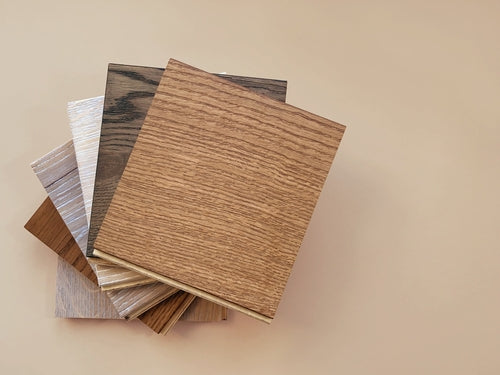
What is the difference between engineered wood and laminate flooring?
Engineered wood and laminate flooring are two of the most popular choices for homeowners.
Each has its own benefits, and both create a stunning finish to your home. So, how do we choose between them? If you’re looking for an easy installation process, laminate may be the way to go.
Stick with Mersey flooring to discover the key differences and browse our products whilst you’re here!
What is Engineered Wood Flooring?
Engineered wood, or man-made wood, is manufactured by binding strands, particles, veneers or fibres with adhesive to create a composite material. This has been designed to be stronger than natural wood, increasing durability and longevity for your home projects.
Engineered wood flooring is made of high-quality plywood covered with a thin layer of hardwood on top. The decorative layer can be made with any thickness. Many choose a thicker layer as it is more durable; however, it is more costly.
You can choose between various options for the top layer, such as Oak, Cherry and Maple. The cover layer of the flooring is typically made from Plywood, high-density or medium-density fibreboard to create a stable foundation.
What is Laminate Flooring?
Laminate wood flooring is a synthetic option made from multiple layers of material fused using a lamination process. This is designed to simulate the appearance of natural wood or stone.
This flooring option is popular with customers as it provides a beautiful look for your home at an affordable price. It is incredibly durable and resistant to scratches, fading, and stains, making it an ideal choice for families with young children.
This type of wood is made from multiple layers; A top protective layer, a high-resolution image layer, a stable core layer, and a backing layer for extra stability.
The Key Differences Between Engineered Wood and Laminate Flooring
Engineered Flooring
- Appearance: Engineered flooring closely resembles hardwood flooring as it has a layer of authentic hardwood on top. This type of floor can come in various colours and finishes, and it ranges in thickness between 0.5 and 4.5mm.
- Durability: It is more stable and can withstand humidity better than laminate flooring. However, it is easier to scratch and dent.
- Maintenance: It requires regular cleaning and occasional refinishing to keep it tidy and maintain its shine.
- Cost: This option is generally more expensive than laminate flooring as it is coated with a top layer of real wood. Although, it is cheaper if you want a natural wood floor.
- Installation: it is typically installed through adhesive, nails, or floating. However, floating floors are more susceptible to damage as they warp easily with high humidity or moisture levels, resulting in costly repairs.
- Environmental impact: Real wood is involved in the composition of engineered wood which requires the logging of trees. The use of VOC adhesives contributes to air pollution and may limit recycling options.
Laminated Flooring
- Appearance: The appearance of laminated flooring depends on the quality of the photographic image. However, high-quality laminate can appear as natural as authentic wood or stone.
- Durability: This option is preferred for its high level of durability as it is resistant to scratches, stains and dents. However, it is susceptible to moisture damage which can’t be refinished.
- Maintenance: It can’t be refinished but is easy to clean. A quick mop or brush will do the job.
- Cost: This flooring is cheaper than engineered wood as it doesn’t require any authentic wood for its composition. The cost varies, however, depending on the quality of laminate you choose.
- Installation: laminate flooring is typically installed using a floating floor process which is fairly durable. However, floating floors are prone to warping. This uses a click-and-lock system, which is a straightforward task.
- Environmental impact: This is typically made from high or medium-density fibreboard, which uses wood chips and sawdust, reducing waste.
Things to consider
Engineered flooring can be installed over a variety of subfloors, such as concrete, and it can be used in basements. The top layer of this floor can be sanded and refinished multiple times to keep it looking brand new long after installation.
However, this option is more costly if you’re on a budget, and it can affect the indoor air quality of your home if it is installed using adhesives.
Laminated flooring is more budget-friendly and long-lasting; therefore, you won’t have to worry about paying for repairs later. With an easy installation process and a range of design and tile patterns to choose from, many customers prefer these products.
However, if your floor does become damaged, it can’t be repaired therefore, a new floor will have to replace it.